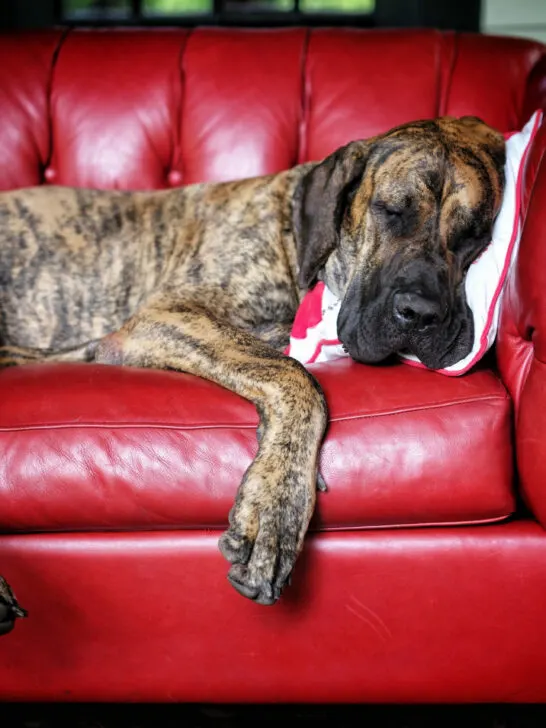Great Danes are large and imposing dogs that are intelligent and beautiful. These dogs have wonderful personalities, are affectionate, and can make an excellent addition to any family.
With their relatively short hair and minimal grooming requirements, this dog may be an attractive option at first glance for people who suffer from pet allergies.
The Great Dane is not a hypoallergenic dog and is prone to shedding.
Although this dog has short fur, the overall size of the breed can produce an increased amount of fur and dander, which can trigger pet allergies.
Regular grooming and routine cleaning may make it possible to mitigate pet allergies while still owning such a large and amazing dog.
If you suffer from pet allergies, especially allergies triggered by fur or dander, choosing a smaller dog may be a better option.
Smaller dogs, even dogs that shed a great deal, will end up being a better choice because they produce less fur overall.
Smaller dogs mean less fur and dander to clean and fewer allergens floating through your home, triggering your pet allergies.
Further, larger dogs like the Great Dane tend to produce more saliva than smaller dogs, which could also trigger an allergic reaction.
What Is Considered Hypoallergenic?
Many people who love pets, but suffer from pet allergies, begin their search for a new furry animal member by looking for hypoallergenic dogs.
What is important to remember is that no dog is going to be 100% hypoallergenic.
Instead, dogs may be labeled as hypoallergenic because they are less likely than other breeds to create an allergic reaction in people. Often, these are dogs that don’t shed as much or produce less dander.
Keep in mind that sometimes people with pet allergies can have allergic reactions to allergens other than fur or dander.
Allergic reactions are pretty common when people come in contact with the skin, oil, or even dog saliva. Unfortunately, even a dog labeled as hypoallergenic will still cause a reaction in this case.
Do Short-Haired Breeds Help?
People with pet allergies will often seek out dog breeds with shorter hair to alleviate their allergy suffering. While there is some logic to this thought process, it is flawed.
Shorter-haired dogs, like the Great Dane, do create less hair floating through the house. Each hair is half the length of a long-haired dog, making less fur overall.
However, if you have a short-haired dog that is a heavy shedder, you could end up with more fur, and more allergens, floating through your home. Short-haired dogs don’t always equate to fewer allergens.
In fact, some short-haired dogs, like the Pug, shed a tremendous amount and can wreak havoc on allergies.
Compare this to a long-haired breed, like the Afghan Hound, that rarely sheds and is considered hypoallergenic.
Do Larger Dogs Make Allergies Worse?
The Great Dane is one of the largest dog breeds around and is considered a giant size dog. Unfortunately, even with an average level of shedding, more dog means more hair.
The larger the dog, the more allergens will be dispersed. The larger dog body means more surface area for fur and dander to generate, which then gets into your home.
Also, consider that many large breed dogs tend to have more prominent jowls and produce more saliva. If your pet allergy is related to dog saliva, you may want to steer clear of large breed dogs and focus your search on smaller dogs.
The smaller the dog, the less dander and fur produced, which can help mitigate your pet allergy symptoms.
How Much Does A Great Dane Shed?
Compared to other dogs, Great Danes are considered moderate to high shedders.
While the dog itself does not shed tremendously more than your average shedder, the sheer size of this dog can make shedding challenging to manage.
Due to the large size and amount of fur this dog can produce is not recommended for people who suffer from severe pet allergies.
The Great Dane will shed the same amount throughout the year and doesn’t go through seasonal changes like some dogs with a thicker coat.
Can Grooming A Great Dane Help With Pet Allergies?
Luckily, if your heart is set on a Great Dane for your next dog, but you suffer from pet allergies, it may be possible to reduce the number of allergens in your home with proper grooming.
Keeping your dog well-groomed can help reduce the number of allergens. The Great Dane has very short fur that covers the entire body.
Grooming is easy with a slicker brush. Simply brush your dog two to three times a week to remove any dead or loose fur that would otherwise float through your home environment.
Be sure to keep up with regular bathing too. Keeping your dog bathed at least once per month can help remove loose fur and dander.
You’ll want to use a moisturizing shampoo, like an oatmeal shampoo, to keep the skin moist.
If the skin becomes too dry from frequent bathing, you can create more dander which could end up irritating your pet allergies even more.
How Labor-Intensive Is Grooming A Great Dane?
Grooming a Great Dane takes time and patience. While the fur is thin and easy to brush through, this is a large dog with a great deal of surface area to cover.
You’ll want to use a slicker brush or a glove to remove the dead and loose fur. To properly groom a Great Dane, you could dedicate thirty minutes to each grooming session.
To help make grooming easier, be sure to get your dog accustomed to brushing at an early age.
The calmer and more compliant your dog is with the grooming process, the easier it will be for you to maintain your grooming routine.
What Can I Do To Reduce Pet Allergies At Home?
A big step you can take to reduce your pet allergy symptoms is to maintain a clean and comfortable home.
Keeping a regular cleaning routine can help eliminate pet fur and dander, which can trigger allergies. Some great ideas to reduce pet allergies in your home include:
- Use Hepa Filters – Hepa filters are a great way to catch even more dirt, dander, and fur cycling through your house. Be sure to replace your filters every month to prevent an allergen build-up.
- Vacuum Daily – To stay ahead of fur and dander accumulation, you’ll want to vacuum every day. The more you vacuum, the less fur you’ll pick up.
- Switch to Hard Surfaces – If possible, replace the carpeting and soft surfaces with hard surfaces like tile or wood. Soft textile surfaces tend to trap fur and worsen pet allergies.
- Wipe Dust – Dander can collect just about everywhere, so be sure to wipe down hard surfaces and hard-to-reach areas. Make sure you wipe down windows, baseboards, ceiling fans, and shelves.
- Wash Pillows – Fur and dander can collect on soft materials like couch cushions and pillows. Be sure to launder your fabrics once a week to keep your home allergen-free.
Can You Test For Pet Allergies Before Pet Ownership?
If you are considering owning a Great Dane or other dog and have had an allergic reaction in the past, it may be possible to test for dog allergies at your doctor’s office.
A skin or blood test can help identify Immunoglobulin E or the protein that makes people allergic to dogs.
Having a test done ahead of time can help determine if pet ownership is right for you. Some people are pleasantly surprised to find out their allergies are triggered by mold or pollen rather than pet dander.
It is important to remember that while allergy tests are a great starting point, they are not perfectly conclusive.
Your test may come back that you are not allergic to dogs but still have mild symptoms when you come in contact with a pet.
Sometimes, over-the-counter medication or improving your cleaning routine can help mitigate allergy symptoms associated with pets.
Related Questions
Do Great Danes make good inside dogs?
Great Danes actually prefer to be kept inside rather than outside. These large and lovable dogs crave human interaction and can become lonely and anxious when kept outdoors.
Further, Great Danes are extremely sensitive to changing temperatures.
In the summer, they easily become overheated, and in the winter, their short coat doesn’t provide enough insulation to stay warm.
While the Great Dane needs to be kept inside, living with a Great Dane can be challenging for allergy sufferers.
Are Great Danes good family pets?
Adding a Great Dane to your family can be a wonderful idea. Not only is the Great Dane loving, but he is incredibly gentle and light-hearted.
This big dog is happy to bounce around and play with children and is tolerant of errant steps, and ear pulls.
If those living in your household can survive a hefty amount of hair and dander, the Great Dane can make a loving family member.
Our team is composed of pet care professionals, veterinarians, and pet owners. To date, we’ve conducted thousands of hours of research to publish the most accurate pet information.
Most of the writers on our site are vets with 10+ years of clinical experience, ranging from small practice, to equine practice, academia, and surgery. Our goal is to help every pet owner get the information they seek about their dear companions.



Leave a comment
You must be logged in to post a comment.